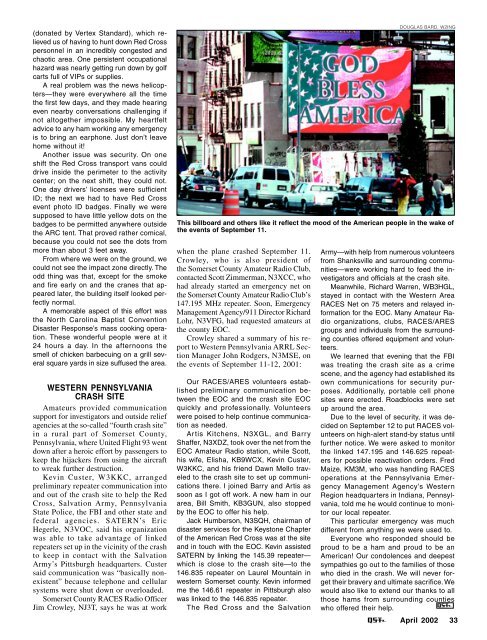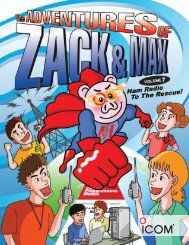SEPT 11 - New York City Amateur Radio Emergency ...
SEPT 11 - New York City Amateur Radio Emergency ...
SEPT 11 - New York City Amateur Radio Emergency ...
You also want an ePaper? Increase the reach of your titles
YUMPU automatically turns print PDFs into web optimized ePapers that Google loves.
(donated by Vertex Standard), which relieved<br />
us of having to hunt down Red Cross<br />
personnel in an incredibly congested and<br />
chaotic area. One persistent occupational<br />
hazard was nearly getting run down by golf<br />
carts full of VIPs or supplies.<br />
A real problem was the news helicopters—they<br />
were everywhere all the time<br />
the first few days, and they made hearing<br />
even nearby conversations challenging if<br />
not altogether impossible. My heartfelt<br />
advice to any ham working any emergency<br />
is to bring an earphone. Just don’t leave<br />
home without it!<br />
Another issue was security. On one<br />
shift the Red Cross transport vans could<br />
drive inside the perimeter to the activity<br />
center; on the next shift, they could not.<br />
One day drivers’ licenses were sufficient<br />
ID; the next we had to have Red Cross<br />
event photo ID badges. Finally we were<br />
supposed to have little yellow dots on the<br />
badges to be permitted anywhere outside<br />
the ARC tent. That proved rather comical,<br />
because you could not see the dots from<br />
more than about 3 feet away.<br />
From where we were on the ground, we<br />
could not see the impact zone directly. The<br />
odd thing was that, except for the smoke<br />
and fire early on and the cranes that appeared<br />
later, the building itself looked perfectly<br />
normal.<br />
A memorable aspect of this effort was<br />
the North Carolina Baptist Convention<br />
Disaster Response’s mass cooking operation.<br />
These wonderful people were at it<br />
24 hours a day. In the afternoons the<br />
smell of chicken barbecuing on a grill several<br />
square yards in size suffused the area.<br />
WESTERN PENNSYLVANIA<br />
CRASH SITE<br />
<strong>Amateur</strong>s provided communication<br />
support for investigators and outside relief<br />
agencies at the so-called “fourth crash site”<br />
in a rural part of Somerset County,<br />
Pennsylvania, where United Flight 93 went<br />
down after a heroic effort by passengers to<br />
keep the hijackers from using the aircraft<br />
to wreak further destruction.<br />
Kevin Custer, W3KKC, arranged<br />
preliminary repeater communication into<br />
and out of the crash site to help the Red<br />
Cross, Salvation Army, Pennsylvania<br />
State Police, the FBI and other state and<br />
federal agencies. SATERN’s Eric<br />
Hegerle, N3VOC, said his organization<br />
was able to take advantage of linked<br />
repeaters set up in the vicinity of the crash<br />
to keep in contact with the Salvation<br />
Army’s Pittsburgh headquarters. Custer<br />
said communication was “basically nonexistent”<br />
because telephone and cellular<br />
systems were shut down or overloaded.<br />
Somerset County RACES <strong>Radio</strong> Officer<br />
Jim Crowley, NJ3T, says he was at work<br />
DOUGLAS BARD, W2ING<br />
This billboard and others like it reflect the mood of the American people in the wake of<br />
the events of September <strong>11</strong>.<br />
when the plane crashed September <strong>11</strong>.<br />
Crowley, who is also president of<br />
the Somerset County <strong>Amateur</strong> <strong>Radio</strong> Club,<br />
contacted Scott Zimmerman, N3XCC, who<br />
had already started an emergency net on<br />
the Somerset County <strong>Amateur</strong> <strong>Radio</strong> Club’s<br />
147.195 MHz repeater. Soon, <strong>Emergency</strong><br />
Management Agency/9<strong>11</strong> Director Richard<br />
Lohr, N3VFG, had requested amateurs at<br />
the county EOC.<br />
Crowley shared a summary of his report<br />
to Western Pennsylvania ARRL Section<br />
Manager John Rodgers, N3MSE, on<br />
the events of September <strong>11</strong>-12, 2001:<br />
Our RACES/ARES volunteers established<br />
preliminary communication between<br />
the EOC and the crash site EOC<br />
quickly and professionally. Volunteers<br />
were poised to help continue communication<br />
as needed.<br />
Artis Kitchens, N3XGL, and Barry<br />
Shaffer, N3XDZ, took over the net from the<br />
EOC <strong>Amateur</strong> <strong>Radio</strong> station, while Scott,<br />
his wife, Elisha, KB9WCX, Kevin Custer,<br />
W3KKC, and his friend Dawn Mello traveled<br />
to the crash site to set up communications<br />
there. I joined Barry and Artis as<br />
soon as I got off work. A new ham in our<br />
area, Bill Smith, KB3GUN, also stopped<br />
by the EOC to offer his help.<br />
Jack Humberson, N3SQH, chairman of<br />
disaster services for the Keystone Chapter<br />
of the American Red Cross was at the site<br />
and in touch with the EOC. Kevin assisted<br />
SATERN by linking the 145.39 repeater—<br />
which is close to the crash site—to the<br />
146.835 repeater on Laurel Mountain in<br />
western Somerset county. Kevin informed<br />
me the 146.61 repeater in Pittsburgh also<br />
was linked to the 146.835 repeater.<br />
The Red Cross and the Salvation<br />
Army—with help from numerous volunteers<br />
from Shanksville and surrounding communities—were<br />
working hard to feed the investigators<br />
and officials at the crash site.<br />
Meanwhile, Richard Warren, WB3HGL,<br />
stayed in contact with the Western Area<br />
RACES Net on 75 meters and relayed information<br />
for the EOC. Many <strong>Amateur</strong> <strong>Radio</strong><br />
organizations, clubs, RACES/ARES<br />
groups and individuals from the surrounding<br />
counties offered equipment and volunteers.<br />
We learned that evening that the FBI<br />
was treating the crash site as a crime<br />
scene, and the agency had established its<br />
own communications for security purposes.<br />
Additionally, portable cell phone<br />
sites were erected. Roadblocks were set<br />
up around the area.<br />
Due to the level of security, it was decided<br />
on September 12 to put RACES volunteers<br />
on high-alert stand-by status until<br />
further notice. We were asked to monitor<br />
the linked 147.195 and 146.625 repeaters<br />
for possible reactivation orders. Fred<br />
Maize, KM3M, who was handling RACES<br />
operations at the Pennsylvania <strong>Emergency</strong><br />
Management Agency’s Western<br />
Region headquarters in Indiana, Pennsylvania,<br />
told me he would continue to monitor<br />
our local repeater.<br />
This particular emergency was much<br />
different from anything we were used to.<br />
Everyone who responded should be<br />
proud to be a ham and proud to be an<br />
American! Our condolences and deepest<br />
sympathies go out to the families of those<br />
who died in the crash. We will never forget<br />
their bravery and ultimate sacrifice. We<br />
would also like to extend our thanks to all<br />
those hams from surrounding counties<br />
who offered their help.<br />
April 2002 33







